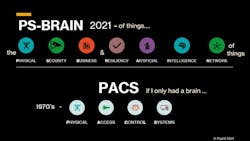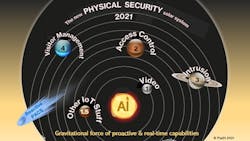The acronym most often used to describe physical security technology is PACS, or physical access control systems. Some might argue that this simply applies to the physical identity access control technology. However, that is a common misconception many have outside the industry—it is not limited to just this single technology. It is, however, centered around a single endeavor, and one that will certainly be seen from now on as just a small fraction of what physical security and safety will be tasked with overseeing.
The main difference between information (systems) and information (technology) is that information systems will incorporate the people, processes and technologies involved with that information. Information technology is limited to the design and implementation of information, or data, within the information system.
Likewise, PACS include the people, processes, and technologies associated with the goal of achieving physical access control. These well-established programs may include a variety of subordinated or integrated technologies, but the US Department of Homeland Security officially lists these as their minimum list of technologies for PACS. Let us not forget, however, that it also includes the supporting personnel and processes necessary to successfully control physical access to a facility, making this term also a synonymous with a job or even department description.
Confused yet? The list below should explain what is included in this definition.
According to the DHS, PACS are comprised of four major functions:
- Visitor management
- Physical access control
- Intrusion detection
- Video surveillance
Historically, physical access control manufacturers interpreted the digitalization of analog systems as convergence, or the migration from analog to digital technologies. This migration allowed them to add video to their list of integrated technologies, for example, to aid in the association of door alarms. This innovation provided a more streamlined approach to clearing and investigating alarms.
Many major brands later added intrusion and visitor management to the growing list of features they would support, though all had one thing in mind: managing physical access. This was a natural marriage of features and technologies—when stitched together, they represented separate but important independent aspects of providing comprehensive controls for physical access. We know what PACS meant to us in the past, but what will PACS mean to us in the future?
Does PACS have a future in physical security?
The short answers are both yes and no. Yes, these technologies will continue to exist, albeit in new wrappers and incarnations, such as mobile devices etc. No, it isn't likely that PACS as a central theme of physical security will have a long future.
In this past year, we have not created any new technology themes, merely accelerated the existing ones. The development of commercially available deep-learning AI products is currently revolutionizing how physical security will organize and operate both now and in the future.
“If PACS was a phone, it would be a clam shell phone," says Bobby Louissant Manager of Technical Solutions GSST at Facebook. "We need to get to smart phone status ASAP. We need interoperability between solutions and sensors connected and managed by a smart system that provides real time data and alert capabilities. We have the eyes, ears, and smell in our systems, but no brain. PACs and Ai offer real-time capabilities for alert management and data context.”
We need to think bigger and broader in terms of what we as physical security professionals will be called to do, as it already has surpassed simply attempting to control physical access to facilities. Current technologies cannot control physical access with any measurable reliability, so something new is needed if we intend to achieve even the most basic of physical security goals. We cannot expect SOC operators to watch video walls, clear thousands of false alarms, and administrate systems and communications any better than they currently do.
This new normal is requiring myriad additional tasks be performed. That list grows daily as we embark on a campaign to assure everyone that their wellness and trust is taken seriously, and that we will instill a sense of real control and safety over the workplace as we move forward. But that is not the end; it is truly just the beginning.
The need to genuinely understand what is happening, from security events to operations to the daily life of the workplace, will be table stakes, driving deeper cross functional engagements and inviting collaboration, intervention, and reinvention. Data will drive effective and efficient solutions in near real-time, thereby enabling every aspect of the workplace to adapt, improve, and thrive. AI will deliver the capability to achieve these goals.
“The idea of autonomous vehicles is already here with many automakers," says Caleb Lau, Global head of Physical Security Systems at Western Digital. "Now we are seeking automation in security technology products. The question is, how that will transform today’s landscape?”
Fighting the move to AI is like fighting with gravity
At the top of every 2021 top-ten technology list, you will find AI. Just as gravity always wins, so will AI. But why is that? It is not physics: if you replace the planets with business functions, then all you need to do is replace the AI with a dollar sign.
"As AI continues to grow rapidly within global industries, a steady importance will arise to process and accelerate real time data and provide clear consistency in operations," says Sal Mani, Global Director of Technical Security at Ripple. "With advances in AI development, more techniques will emerge for larger data sets to be processed at the edge using minimal hardware without losing performance. This will be considered the norm. Now is an opportunity to rethink every aspect of how we live and consume."
Physical security is no different than any other enterprise. We have people, processes, and technology that comprise the systems we utilize to support our business functions. Just like every other business function, efficiency and scalability equals dollars. No matter how evolved we get, we can only deal with a finite number of bananas, and that is where we have been for the last 30 years--sitting in rooms, watching video walls, attending to 99% false positive alarm screens, and eating the occasional banana.
The gravity of efficiency and effectiveness is the universal gravitational force that will drive this next chapter of digital transformation, culminating in a system that has many of our strengths and almost none of our limitations: AI-transformed security operations.
“People who think AI will not change the industry completely, probably also believe mobile technology will not change access control," says Jamie Connor, Customer Support & Operations Specialist at Safetrust. "It’s time for the industry to wake up and follow the lightship back to shore.”
About the Author



